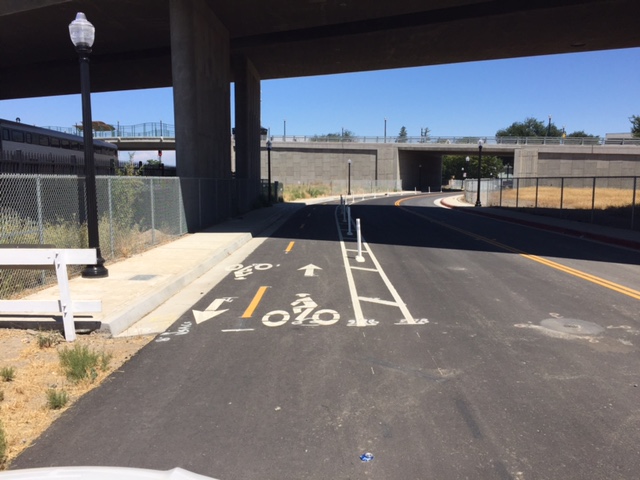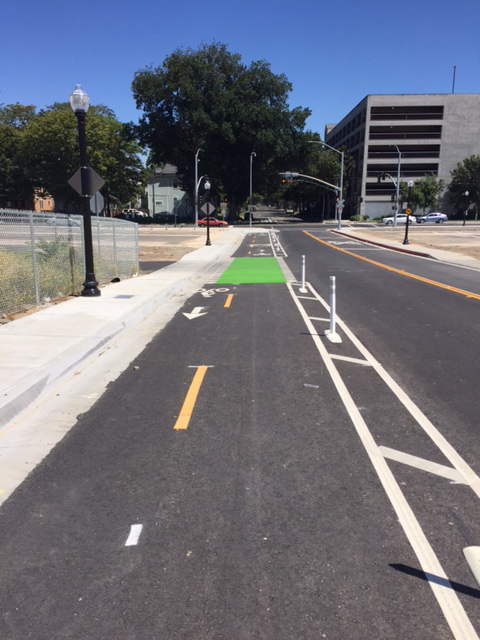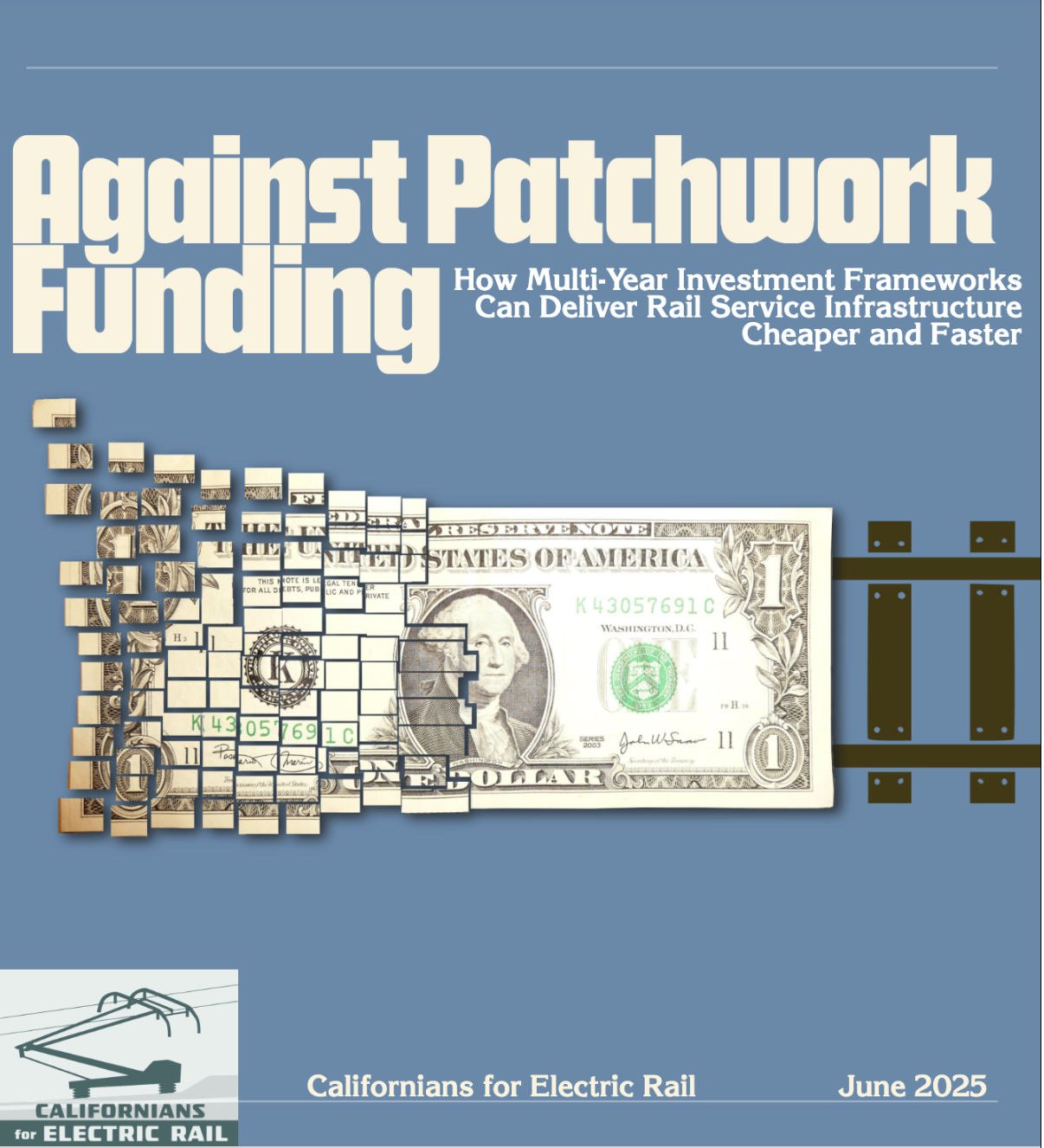Streetsblog reader Darren Conly sent in pictures of Sacramento's first official protected bikeway: a short cycletrack near the downtown Sacramento Amtrak station. The two-way bikeway, set off from traffic with buffers and posts, connects a portion of F Street between 7th and 5th streets, where before there was only a fire road.
As Conly points out, it currently comes to a dead end at 5th Street, under the new bridge that crosses the railroad tracks.
Jennifer Donlon Wyant, the city's Active Transportation Specialist, said that by next summer the bikeway will connect to the Amtrak covered platform area. The project is currently in the design phase, she said, but the funding to build it is ready.
The final route to the station has not yet been finalized pending coordination with the fire department and plans for a light rail station in that area, but when it is completed it will give Amtrak riders a direct bike connection from the station platforms to F Street, which is one of the city's low-stress bikeways.
Other changes coming to the station area include what Donlon Wyant calls a “Bike SPA”—Secure Parking Area—just outside the recently refurbished station building. “I don't like to call them cages,” she said. “You put scary things in cages—and bikes are not scary.” The Bike Spa will be a glass-enclosed, secure bike parking area with double decker racks.

Also in the works is a bike-share “preview” hub to go in near the station, probably next month. The eagerly anticipated Sacramento bike-share system is in its final planning stages, and right now there is a small “preview” available with fifty bikes and twelve stations in the downtown area. “We'll be rolling out additional bikes in the next month while we wait for SACOG to work out final contracting agreement with Social Bicycles,” said Donlon Wyant. “We're hoping to get it done quickly.”
Meanwhile the city has been adding bike facilities and encouraging people to ride. Last year saw a new pedestrian/bike bridge connecting City College over the railroad tracks to the residential development at Curtis Park, the creation of city-run bike skills classes, and an Open Street event along Broadway, among other efforts. The city also completed a network gap by adding a one-mile bike lane along Freeport Boulevard that included a road diet and new left turn pockets. That project was championed and led by high school students at McClatchy High School, and required extensive community input as the road diet was contentious—at least, before it was built.
“We did receive a few calls after the road diet went in about travel speeds along that corridor,” said Donlon Wyant. “The corridor was just at the threshold of what we would consider for a road diet, with somewhat high traffic volumes. But after some initial concern, it's now running smoothly for all modes,” she said.
Excited as she was by past achievements, Donlon Wyant has her eyes on the future. “In one year, we were able to add infrastructure that made the city markedly different,” she said. “Next year will be a banner year for bikeway facilities. We've really leapt forward in how we address bicycling in the city; we're being more aggressive and doing things faster with the limited resources that we have.”
One thing that changed was that the city's bike and pedestrian planning staff doubled—to two people. “It used to be only me,” she said. “This will help us get a lot more done.”
The Sacramento City Council also recently allocated $2.25 million for bike improvements in Sacramento, which, as Donlon Wyant pointed out, is very rare—most cities won't fund transportation from their general fund.
That money comes with some geographic equity requirements, so each of the city's eight council districts will get something—perhaps improved trail crossings or new bike lanes. “Where we will be getting the most improvements for the dollar,” said Donlon Wyant, “is in downtown, where we are planning new bikeway projects that will be quick and cost-effective.” Those are road diets on P, Q, and 10th streets—all one-way streets—which will be narrowed from three lanes to two and have bike lanes added.
“Also, we will fix a gap on H Street, which had a bike lane put in a few years ago but it was left out between 13th and 15th because the traffic planning was complicated there. And we will be adding a one-block bike lane to complete a gap on I Street between 12th and 13th,” she said.
Other upcoming projects include the city's first bike box, its first two-stage turn box, and a bike signal near Sacramento State. On top of that, the city will add a number of Complete Streets projects as part of their regular resurfacing plan, including a bike lane on 24th street.
And then there are two cycletracks in the planning stages, for which the city received grants from the Active Transportation Program: along north 12th street, which is complicated by the light rail that runs there, and along Franklin Boulevard. Those two projects should be completed between 2019 and 2020.
Donlon Wyant is proud of what the city has been able to do with a relatively small amount of money. Sacramento's transportation sales tax measure does not provide as much funding as similar Bay Area measures. “It takes longer to get things done when you rely on grants and have to come up with matching funds,” she said.
She analyzed how much the city spends on walking and biking, and found that overall Sacramento spends a larger portion of its transportation budget—a little over twenty percent—on walking and biking facilities than other cities comparable in size and population. But, she says, the city's overall transportation budget is smaller than, for example, Oakland's.
Still, the portion of its budget a city spends on biking and walking says a lot about where its priorities are. Many state transportation budgets, California included, dedicate one percent or less to improving bike and pedestrian facilities, and for many city budgets, ten percent is pretty high.
“We're really invested in improving conditions for biking on our streets,” said Donlon Wyant. “We've done a lot, and we're going to continue to do a lot more.”
Donlon Wyant is also looking forward to the California Bicycle Coalitions' Bike Summit, coming up in October. It will take place in Sacramento, and offers a chance to take a tour of some of these new facilities.
Streetsblog readers: Have you noticed a new bike lane or bridge or pedestrian amenity or signal going up in your community? California is a big state, and we rely on your eyes on the street to let us know. Send tips and photos to melanie[at]streetsblog.org






